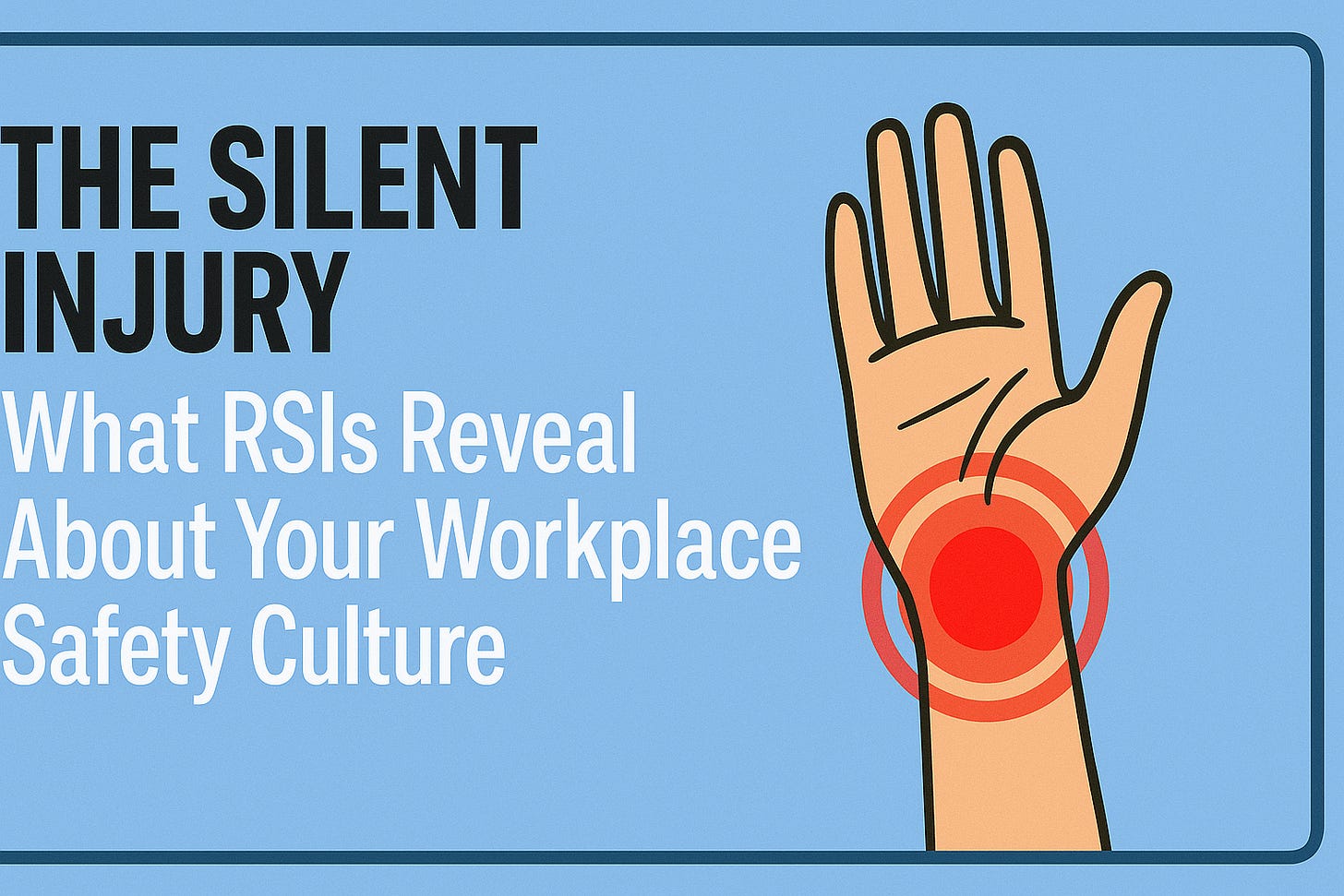The Silent Injury: What RSIs Reveal about your Workplace Safety Culture
Hello and welcome to this week’s edition of Safety Pro Weekly.
Many organizations treat repetitive strain injuries as an inevitable part of the job, rather than recognizing them as a preventable workplace hazard.
Repetitive Strain Injuries or RSIs are soft tissue injuries caused by repetition, overexertion or awkward postures. They include injuries like strains, sprains, muscle pulls or even carpal tunnel syndrome.
RSIs often function like the canary in the coal mine of your safety program. They can often be a sign of a deeper cultural problem that has gone unnoticed. Unlike forklift accidents or slips, trips and falls, they aren’t immediately identifiable and can take a long time, sometimes months or years to build into something that prevents workers from doing their job.
In this article:
RSIs are a significant cause of workplace injuries.
Because they build over time, they are difficult to identify and often ignored.
Encouraging early reporting is the best way to prevent RSIs from becoming more serious.
RSIs can be a test of workplace culture and the openness of your reporting process.
Because they build slowly, RSIs are often dismissed as general aches and pains or even a sign of aging, which delays intervention and thus extends the time to recovery. As a result, they are one of the most costly injuries for employers, with the average direct and indirect cost of a single RSI hitting approximately $40,000 per year. But the effects of RSIs extend even further than cost. RSIs are like termites in your house, you don’t notice the damage until it’s too late. And by then the repair bill is huge.
Here’s the thing that most business leaders miss: RSIs aren’t just a physical hazard, they’re a cultural test.
Early reporting of pain should be the norm. But in many workplaces, speaking up is passively or actively discouraged. This reluctance often has a spillover effect in that workers who are reluctant to report early pain from RSIs are also less likely to report unsafe conditions or near misses. Encouraging early reporting of injury allows for treatment before the injury becomes serious enough to require time off work or medical attention.
Why it Happens
There are a number of reasons why RSIs go unreported or underreported by workers.
Slow Onset: Workers often don’t notice or take action on it until the pain becomes too persistent to ignore.
Fear of Speaking up: Employees fear being seen as weak or as being a complainer, so they stay silent.
Workplace Culture: Businesses that discourage reporting or shame employees for speaking up create a culture of fear that leads to hazards of all kinds going unreported until the situation becomes dire.
Productivity pressure: Supervisors sometimes prioritize production at the expense of worker comfort. Unfortunately this can lead to bigger productivity losses due to injury in the longer term.
How to Fix It
Fortunately there are a number of things you can do to reduce the impact of RSIs in your business, maintain productivity and minimize injury costs.
Encourage early reporting: Encourage workers to speak up about pain and train supervisors to take even minor discomfort seriously. Early treatment can prevent a more seriously, costly injury down the road.
Task Rotation: Train workers on multiple tasks and schedule job rotation where appropriate. This has the added benefit of having workers trained to cover absences or vacation time without loss of efficiency.
Look for opportunities to make small, practical adjustments. Can you make small tweaks to a task to make it more ergonomically efficient? Are there ways to allow for mechanical assistance? Does the task have to be done in the first place or are there ways to substitute or eliminate it?
Measure more than just incidents: Look for leading indicators in the work you do. Number of safety observations, perhaps, or equipment inspections, training completed, safety discussions and the like. Incidents are lagging indicators which means they measure incidents that have occurred in the past. Look instead for process items that contribute to a safer overall workplace.
Promote psychological safety: Workplaces where employees feel safe to speak up and present dissenting opinions without fear of censure give workers the peace of mind to report injuries sooner so they can be addressed before they become serious.
Ignoring RSIs does not make them go away. It allows them to fester into a bigger, more serious and more costly problem that takes much longer than necessary to resolve. Soreness is not a normal part of work or of age. Encourage employees to report even minor soreness so that the issue can be dealt with before it becomes more serious.
That’s it for this week. Are you struggling with RSIs in your workplace? What have you done about it? Does management encourage early reporting or does it tacitly encourage employees to hide the pain. Let me know in the comments.
Safety Pro Weekly is published every Tuesday on LinkedIn and Substack.
Until next week,
Cheers,
Dan.





